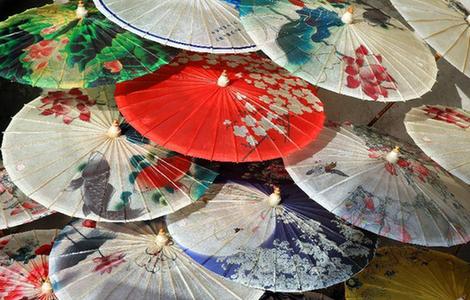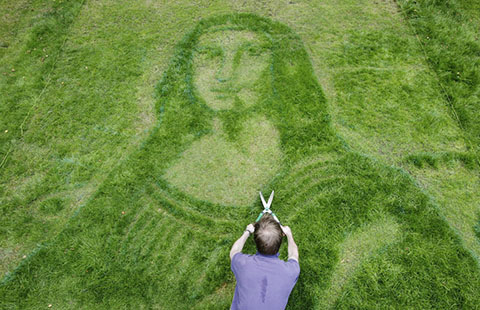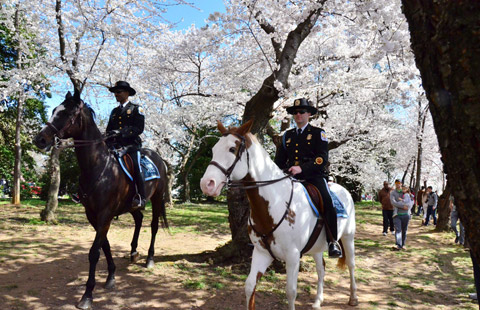Iraqi artist puts trauma onto canvas
Updated: 2015-04-15 07:13
(Agencies)
|
||||||||
 |
|
Iraqi painter Ammar Salim poses near one of his art pieces at his workshop in the Iraqi Kurdish city of Dohuk, on March 26. [Photo/Agencies] |
A jihadist fighter slits a man's throat. Another brandishes a severed head, spiked on his rifle, as more militants dump bodies into a trench overflowing with corpses.
This is how painter Ammar Salim depicts the atrocities Islamic State extremists perpetrated against his minority group-the Yazidis-in northern Iraq last summer.
In his tiny apartment in Dohuk, in Iraq's Kurdish region, Salim has attempted to put the collective memories of his community on canvas in a series entitled The Yazidi Genocide.
This particular piece, his most recent, includes more than 100 characters and was inspired by mass graves found in the Sinjar area.
"Most people fight through weapons, writing or the press. I said I'd fight through art," Salim says. "I want people to see what they haven't seen."
The paintings, including many crowded and colorful scenes reminiscent of Renaissance depictions of Hades, are intentionally shocking.
One work depicting the fall of Sinjar shows women being raped, killed and carried away. Another presents cackling jihadists buying and selling Yazidi women in the city of Mosul, their main hub in northern Iraq.
Salim fled the town of Bashiqa when IS fighters took over Mosul in June in an onslaught that overran large areas of Iraq. During a second offensive in August, the jihadists targeted areas in the north that were home to many Iraqi minorities.
The Yazidis, who are neither Muslims nor Arabs, and who practice a unique faith that makes them infidels in the eyes of the jihadists, were hit harder than others.
They appeared to be in danger of being wiped out of their ancestral land until a US-led air campaign turned the tide on IS advances.
"When you have a stable life you can give beauty," Salim says. "When you are in such a miserable life, you have to talk about what's inside you."
The culmination of this trauma has led not only to Salim's portrayals of IS militants but also to other, more fanciful, manifestations of suffering.
In one painting, which he describes as "a forest of hell", he depicts a road leading to the Yazidi holy site of Lalish. The trees lining the road, linked by chains, are shaped like women crying out to the heavens.
The background is a blood-red sunset mixed with burned oranges and yellows.
Asked if the pain and suffering in his paintings has become a key part of Yazidi life, Salim says: "It has become all of our life."
The series so far consists of seven paintings, but Salim hopes it will eventually grow to include 20 pieces.

 Oil paper umbrellas made in Sichuan
Oil paper umbrellas made in Sichuan
 Ex-student sought in shooting death of North Carolina college
Ex-student sought in shooting death of North Carolina college
 Women in politics - Hillary Clinton is just one of them
Women in politics - Hillary Clinton is just one of them
 10 Red Dot Award winning carmakers in '14
10 Red Dot Award winning carmakers in '14
 Get a birthday cake for your pets
Get a birthday cake for your pets
 7 ways to beat 'spring sleepiness'
7 ways to beat 'spring sleepiness'
 Legendary painting of Mona Lisa recreated
Legendary painting of Mona Lisa recreated
 National festival underway with cherry blossoms in peak bloom
National festival underway with cherry blossoms in peak bloom
Most Viewed
Editor's Picks

|

|

|

|

|

|
Today's Top News
US to help smart cities
Clinton's win not guaranteed despite global celebrity
US has record number of applications for H-1B tech visas
Chinese economy to slow more: World Bank report
China's slow down has upside
US voluntary medical team funded for China trip
Hilary Clinton launches
presidential campaign
'No room' for election China-bashing: US politicians
US Weekly

|

|






